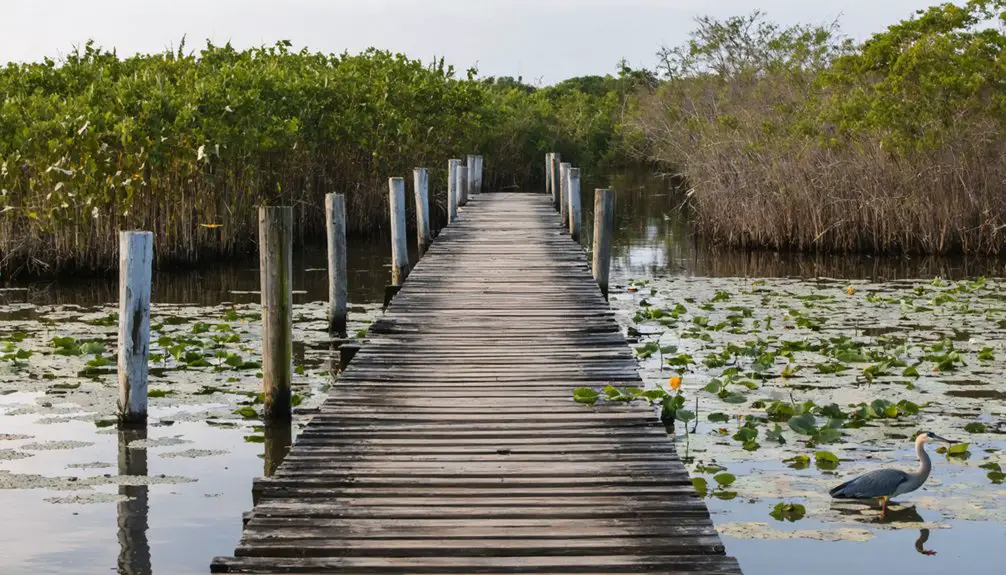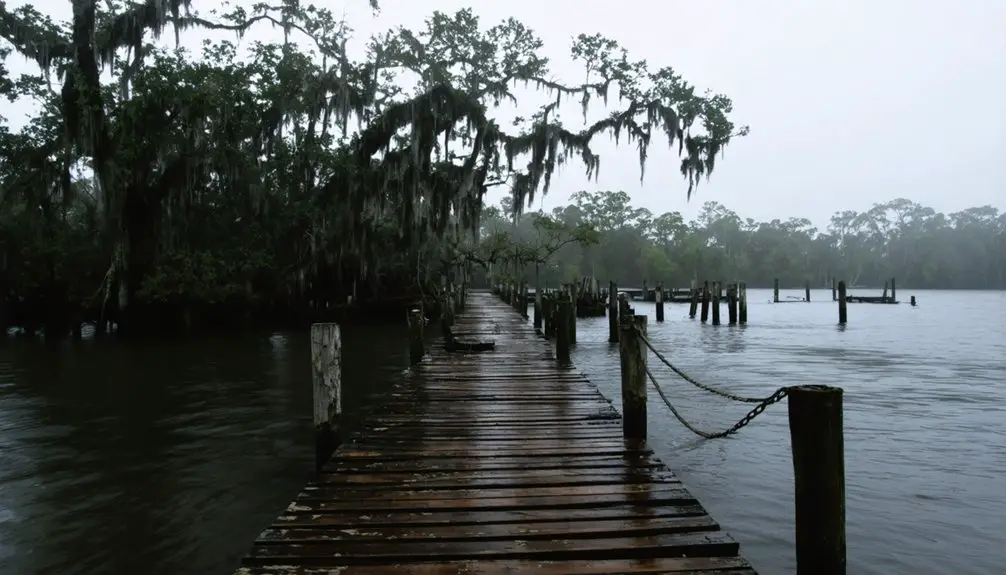You’ll discover Tiger Bay’s haunting remains within Florida’s Tiger Bay State Forest, where a once-bustling turpentine community thrived in the early 1900s. The ghost town grew alongside Pershing Highway, Florida’s first brick-paved road built in 1917, connecting DeLand to Daytona Beach. Today, you can explore 2.4 miles of the original brick road, scattered Herty cups, and camp remnants while wandering through pine forests and wetlands that hold countless untold stories.
Key Takeaways
- Tiger Bay was a thriving turpentine community in early 1900s Florida, centered around the Buncombe Hill/Stillman Turpentine Camp operated by Consolidated Tomoka Land Company.
- The town’s remains include scattered Herty cups, broken crockery, and glass bottles from former turpentine camp activities.
- The abandoned Pershing Highway, Florida’s first brick road built in 1917, now serves as a historic reminder of Tiger Bay’s past.
- Tiger Bay’s decline coincided with the end of Florida’s turpentine industry dominance and the replacement of Pershing Highway by US 92.
- The area is now Tiger Bay State Forest, preserving historical artifacts and offering hiking trails through former settlement locations.
The Rise and Fall of a Turpentine Town
While Florida’s early economy relied heavily on various industries, the turpentine trade emerged as a powerhouse in Tiger Bay during the early 1900s.
You’ll find the area’s history deeply rooted in naval stores, where skilled workers extracted valuable resins and turpentine from the abundant pine forests. The economic impact was profound – Florida dominated turpentine production from 1905 to 1923, surpassing even Georgia’s output. Today, visitors can find scattered Herty cups throughout the forest, evidence of the collection methods used over a century ago.
At the heart of this boom stood the Buncombe Hill/Stillman Turpentine Camp, operated by Consolidated Tomoka Land Company. The site, now part of Tiger Bay State Forest, was acquired by the state in 1994.
Workers used clay pots and metal gutters to collect resin from scarred pines, creating the distinctive “catfaces” you can still spot today. The industry’s prosperity fueled local growth until the 1930s when market changes and depleted resources led to its collapse, leaving behind only scattered remnants of Tiger Bay’s once-thriving turpentine empire.
Life Along Pershing Highway
If you’d visited Tiger Bay in 1917, you would’ve traveled along the newly constructed Pershing Highway, the first brick-paved road connecting DeLand to Daytona Beach.
The durable brick pavement, named after World War I General John J. Pershing, formed part of the Pershing Triangle that linked the region’s major communities and facilitated essential commerce between them. No vehicle traffic is permitted on the historic road segment today.
Today, you can still walk or bike along a preserved mile-long segment of this historic thoroughfare in Tiger Bay State Forest, where the original brick construction stands as a tribute to early 20th-century road engineering. The road was eventually abandoned in 1940s when the modern Highway 92 was completed.
Early Transportation Routes
Since its construction in 1917, Pershing Highway served as one of Florida’s earliest paved thoroughfares, connecting the bustling coastal city of Daytona Beach to inland DeLand.
You’ll find historical significance in its brick construction, which proved durable enough that 2.4 miles still exist today within Tiger Bay State Forest. Its original eight-foot wide path was designed to accommodate early automobile traffic. This essential route formed part of the Pershing Triangle, linking Daytona, DeLand, and New Smyrna Beach during a critical period of transportation evolution in Florida’s history.
As you explore the area’s past, you’ll discover how this highway supported regional growth and commerce through the challenging terrain of timber stands and swampland. The road’s construction utilized high-quality hardware similar to other major infrastructure projects of the era.
Named after WWI General John J. Pershing, the road symbolized post-war infrastructure advancement until Highway 92’s completion in the late 1940s rendered it obsolete.
Brick Road Legacy
The legacy of Pershing Highway‘s original brick road stands as a tribute to Florida’s early transportation ingenuity, with a preserved mile-long segment now serving as an interpretive trail within Tiger Bay State Forest.
The brick road’s significance dates to 1917 when it first connected DeLand to Daytona Beach as part of the “Pershing Triangle.” You’ll find this historic thoroughfare, named after WWI General John J. Pershing, protected under state archaeological laws. The forest’s ongoing restoration efforts help maintain the surrounding natural pine flatwoods that line this historic pathway.
While walking the trail, you’ll discover interpretive kiosks revealing the area’s rich history, including remnants of early 20th-century life from turpentine camps and homesteads. This road remained an essential transportation route until US 92 replaced it in 1947.
Historical preservation efforts by the Florida Forestry Service maintain this valuable piece of transportation infrastructure, though you’ll need to respect the no-vehicle policy that safeguards its structural integrity.
Exploring Tiger Bay’s Historical Remnants
While exploring Tiger Bay’s remnants, you’ll find brick fragments and Herty cups scattered near the former Buncombe Hill/Stillman Turpentine Camp, where workers once extracted valuable pine resin in the early 1900s.
You can trace their footsteps along the preserved mile-long section of Pershing Highway, a historic brick road that connected DeLand to Daytona Beach until its abandonment in the 1940s.
Similar to Hampton Springs Hotel, the site holds important archaeological value with scattered artifacts revealing past industrial activities. Your journey through Tiger Bay State Forest reveals these carefully preserved artifacts and road sections, though you’ll need to resist collecting any historical items to maintain the site’s integrity. The area was once operated by Consolidated Tomoka Land Company, which managed the extensive turpentine operations in the region.
Turpentine Camp Life
Modern-day explorers walking through Tiger Bay State Forest encounter scattered remnants of a once-bustling turpentine operation that defined early 20th-century life in this corner of Volusia County.
You’ll find evidence of daily camp activities scattered among the pines – Herty cups that once collected precious resin, broken crockery from worker housing, and old glass bottles that tell tales of life in the wilderness.
Workers spent their days carving “catfaces” into pine trees, collecting the valuable sap that would be distilled into turpentine.
Their homes and workspaces lined the logging roads, creating a self-contained community deep in the forest.
The rustic camp store supplied their basic needs, while the isolation of their surroundings shaped a unique way of life centered around Florida’s booming naval stores industry.
Pershing Highway Discoveries
Hidden beneath towering pines and draped in Florida humidity lies a remarkable piece of early automotive history – the brick-paved Pershing Highway that once served as the first direct route between DeLand and Daytona Beach.
You’ll find this preserved segment within Tiger Bay State Forest, where a 2.4-mile round-trip trail follows the original 1917 roadway.
Named after WWI General John J. Pershing, this historic highway formed part of the Pershing Triangle connecting three major cities until its abandonment in the late 1940s.
Today, you can walk the same brick path that early Florida motorists once traveled, though vehicle access is prohibited to protect this precious remnant.
While exploring, you’ll encounter interpretive signs and benches, offering glimpses into early 20th-century transportation, but remember – the bricks must stay put.
Natural Wonders of the State Forest
Nestled between ancient marine terraces, Tiger Bay State Forest showcases a remarkable wetland ecosystem that covers over 40% of its terrain.
You’ll discover pine islands scattered throughout the swamps, creating a mosaic of habitats that support incredible wetland biodiversity. The forest’s network of lakes and ponds, including Indian Lake and Scoggin Lake, provides excellent fishing opportunities and wildlife viewing.
You can explore these natural wonders along the two-mile Buncombe Hill Trail, where scenic trails wind through loosely growing pines and oak hammocks.
Whether you’re camping at one of the primitive equestrian sites or tracking wildlife along the forest paths, you’ll experience a pristine wilderness dotted with wildflowers and inhabited by deer, foxes, hawks, and countless bird species.
Conservation Efforts and Wildlife Protection

The extensive conservation program at Tiger Bay State Forest stands as a model for ecological restoration in Florida.
Tiger Bay State Forest exemplifies Florida’s commitment to ecological restoration through its comprehensive and innovative conservation initiatives.
You’ll find dedicated teams conducting pine thinning, prescribed burns, and hydrological enhancements across 2,500 acres of restored land. These efforts directly support wildlife corridors and habitat restoration for native species throughout the Halifax River Basin.
The project’s success relies on partnerships between Biotech Consultants, Gulf Coast Land Management, and regulatory agencies.
They’ve implemented systematic monitoring and adaptive management strategies to guarantee ideal conditions for Florida’s diverse wildlife. Through careful wetland protection and water flow restoration, you’re witnessing the transformation of previously disturbed landscapes into thriving ecosystems.
The restored habitats now serve as essential refuges for birds, amphibians, reptiles, and mammals endemic to Florida wetlands.
Modern Day Adventures in Tiger Bay
While exploring Tiger Bay State Forest today, you’ll discover a fascinating blend of historical remnants and natural wonders along its network of trails.
You can trek the mile-long Pershing Highway, an abandoned brick road that once connected DeLand to Daytona Beach, or venture deeper into the forest for geocaching adventures around the old Buncombe Hill turpentine camp.
The swamp and forest terrain offers prime opportunities for wildlife photography, especially during drier seasons. You’ll find scattered Herty cups and brick remnants from the 1900s while traversing the wilderness.
For extended adventures, you can combine hiking with kayaking in the swamp areas or set up camp in designated zones. Remember to leave historical artifacts untouched as you explore this unique landscape where past meets present.
Frequently Asked Questions
Are There Any Reported Ghost Sightings or Paranormal Activity in Tiger Bay?
You won’t find documented ghost stories or official paranormal investigations from Tiger Bay itself, despite its historical significance. The surrounding areas like Cassadaga have paranormal reports, but Tiger Bay doesn’t.
What Happened to the Families Who Lived in Tiger Bay?
Imagine the Johnson family packing their wagon as Tiger Bay’s turpentine industry collapsed. Like them, most families were forced to migrate when logging camps closed, seeking work elsewhere as industries declined.
Is Overnight Camping Allowed in Tiger Bay State Forest?
Yes, you can camp overnight in Tiger Bay State Forest with proper permits. The forest’s camping regulations allow you to use primitive sites with amenities like fire rings, picnic tables, and grills.
Can Metal Detectors Be Used to Search for Historical Artifacts?
Like a treasure map torn in two, metal detecting in Tiger Bay clashes with historical preservation laws. You can’t search for artifacts here – it’s protected state land requiring strict preservation.
What Is the Best Time of Year to Visit Tiger Bay?
You’ll find the best season to visit is winter (December-February), when cooler, drier weather conditions make hiking more comfortable and insects are less active on historic trails.
References
- https://floridatrailblazer.com/2017/08/01/old-turpentine-camp-at-tiger-bay-state-forest/
- https://floridatrailblazer.com/tag/tiger-bay-state-forest/
- https://en.wikipedia.org/wiki/Tiger_Bay_State_Forest
- https://en.wikipedia.org/wiki/List_of_ghost_towns_in_Florida
- https://floridapolitics.com/archives/650502-five-questions-for-mayors-at-suncoast-tiger-bay-state-of-the-bay/
- https://sites.google.com/site/taylorcountyhistory/home/9b-turpentine-stills-in-taylor-county
- https://floridatrailblazer.com/tag/turpentine/
- https://floridahikes.com/buncombe-hill-hiking-trail/
- http://www.outintheboonies.com/Tiger_Bay/
- https://www.youtube.com/playlist?list=PLKw1INzz04287eViVlK5s6ai_tjVlDzjD



